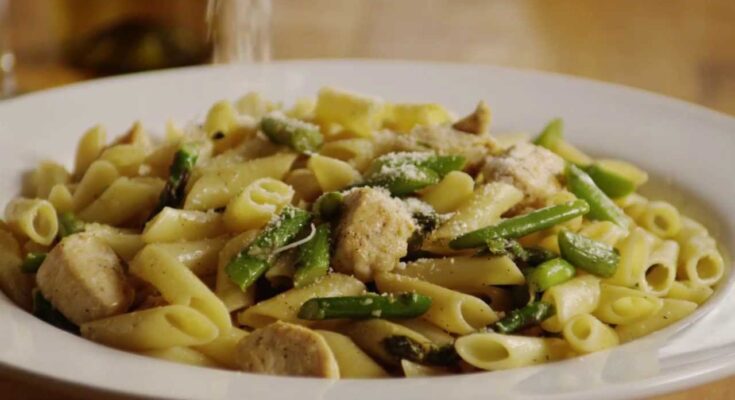Asparagus Pasta Recipe: There’s something special about the simplicity of pasta dishes that just hit the spot—especially when you combine it with seasonal vegetables like asparagus. This asparagus pasta recipe is fresh, vibrant, and surprisingly easy to make. Whether you’re prepping a quick weeknight dinner or something elegant for guests, this dish is your go-to.
What makes it stand out? It’s the combination of crisp-tender asparagus, the richness of garlic and lemon-infused olive oil, and the magic of a well-cooked pasta. Each forkful bursts with flavor while keeping things light and healthy. Ready to impress your taste buds? Let’s dive in!
Why You’ll Love This Asparagus Pasta Recipe
This recipe isn’t just a treat for your taste buds—it’s also fast, flexible, and fits any season. It’s vegetarian-friendly, full of nutrients, and comes together in under 30 minutes. Plus, it’s the kind of dish that can be dressed up or down. Want it creamy? Add a splash of cream. Want it vegan? Skip the cheese and use nutritional yeast. Cooking doesn’t get more adaptable than this.
Think about it: how many recipes hit the perfect balance between comfort and freshness? Not many. This one does—and it’ll quickly become a favorite in your weekly meal rotation.
Health Benefits of Asparagus
Asparagus isn’t just delicious—it’s packed with health benefits that make this pasta dish even more of a win. It’s rich in fiber, vitamins A, C, E, and K, and is a great source of folate. This means it’s good for your heart, helps digestion, supports your immune system, and even contributes to healthy skin.
Also, asparagus is low in calories and high in antioxidants. So, if you’re trying to eat clean without sacrificing flavor, you’re on the right track with this dish.
Choosing the Right Pasta for This Recipe
Long vs. Short Pasta: Which Works Best?
Choosing the right pasta shape can make or break your dish. For asparagus pasta, both long and short pasta work. But here’s the kicker—each one offers a slightly different experience.
- Long pasta like spaghetti, linguine, or fettuccine gives you that satisfying twirl and pairs beautifully with the silky sauce.
- Short pasta like penne, fusilli, or farfalle catches bits of asparagus and sauce in every bite.
Gluten-Free and Whole Wheat Options
If you’re gluten-intolerant or just trying to eat a little healthier, go for gluten-free pasta made from rice, quinoa, or lentils. Whole wheat pasta adds extra fiber and a nuttier flavor that complements the earthiness of asparagus.
List of Ingredients You’ll Need
Fresh Produce
- 1 bunch of fresh asparagus (about 1 lb)
- 3-4 cloves of garlic, minced
- 1 lemon (zest and juice)
- Fresh parsley or basil (for garnish)
Pantry Staples
- 12 oz pasta (linguine, penne, or your choice)
- 3 tbsp extra virgin olive oil
- Salt and black pepper (to taste)
- Crushed red pepper flakes (optional, for a kick)
- Grated Parmesan or Pecorino Romano cheese
Optional Add-ins
- Cherry tomatoes (halved)
- Mushrooms (sliced)
- A splash of cream or butter for richness
- Pine nuts or almonds for crunch
How to Prepare Asparagus for Cooking
Trimming Techniques
Asparagus can be a bit fibrous at the bottom, so trimming is crucial. The easiest method? Snap it! Hold both ends of the stalk and bend—where it naturally breaks is where the woody part ends. Do this for a few stalks and then cut the rest to match.
Blanching vs. Roasting
- Blanching (boiling briefly, then shocking in ice water) keeps the color vibrant and texture crisp.
- Roasting brings out a deep, earthy flavor with a hint of caramelization.
For pasta, a quick sauté works wonders—you’ll keep the flavor and texture just right.
Step-by-Step Guide to Making Asparagus Pasta
Let’s cook this beauty step-by-step.
Step 1: Cook the Pasta Al Dente
Boil a large pot of salted water. Add the pasta and cook according to package instructions until al dente (firm to the bite). Reserve 1 cup of pasta water before draining—this will help bring everything together later.
Step 2: Prep and Cook the Asparagus
While the pasta cooks, trim and cut asparagus into 1-2 inch pieces. Heat 1 tablespoon of olive oil in a large pan over medium heat. Toss in the asparagus and sauté for 5-7 minutes until tender-crisp. Add a pinch of salt.
Step 3: Create the Flavor Base (Garlic, Lemon, Olive Oil)
In the same pan, push the asparagus to one side. Add the remaining olive oil and minced garlic. Sauté for 1-2 minutes until fragrant—don’t burn the garlic! Add lemon zest and a squeeze of lemon juice.
Step 4: Combine Everything in One Pan
Toss the drained pasta into the pan with the asparagus. Add a bit of the reserved pasta water (start with ¼ cup) and stir to create a light, silky sauce that coats everything beautifully. Add more water if needed.
Step 5: Finish with Cheese and Herbs
Turn off the heat. Sprinkle in grated cheese and freshly chopped herbs. Toss everything until the cheese melts into the sauce. Taste and adjust seasoning—add more lemon, salt, or pepper if needed.
Creamy Asparagus Pasta Variation
Want to turn your simple asparagus pasta into something extra indulgent? Add a creamy twist! A splash of heavy cream or a dollop of cream cheese can elevate this dish into a rich, comforting bowl that still feels fresh and vibrant thanks to the asparagus.
Here’s how to do it:
- After sautéing the garlic and asparagus, lower the heat and add about ½ cup of heavy cream.
- Let it simmer gently for 2-3 minutes, allowing the flavors to blend.
- Stir in grated Parmesan cheese for that luxurious texture and extra depth.
- Toss in your cooked pasta and mix until everything’s well-coated in that creamy, dreamy sauce.
This variation is perfect for cozy nights when you want something hearty but still veggie-packed. You can even sprinkle some toasted pine nuts or crushed walnuts on top for an added layer of richness and crunch. It’s pasta night with a five-star feel—without the restaurant bill.
Vegan Asparagus Pasta Option
Going plant-based? No worries—this recipe transforms beautifully into a vegan dish without losing any of its appeal. Skip the cheese, and instead, use a few vegan-friendly swaps to keep the flavors bold and satisfying.
Here’s what to change:
- Use olive oil or vegan butter for the sauté.
- Replace Parmesan with nutritional yeast—it adds a cheesy, umami flavor without the dairy.
- Want creaminess? Add a splash of coconut milk or cashew cream in Step 4.
- Boost the flavor with lemon juice, garlic, and maybe even a pinch of smoked paprika for an extra kick.
Top with fresh herbs like basil or parsley, and maybe a sprinkle of vegan parmesan or crushed almonds. You’ll still get that bright, garlicky, lemony goodness—just 100% plant-based.
Serving Suggestions
Once your pasta is ready, you might wonder: what should I serve with it? While this dish holds up beautifully on its own, adding a few extras can turn your meal into a full-on feast.
Protein Pairings
- Grilled chicken or lemon herb shrimp works wonders alongside asparagus pasta.
- For vegetarians, top it with a poached egg—the yolk adds creaminess.
- Tofu or chickpeas are great vegan options that provide both texture and protein.
Side Dishes
- A crisp green salad with a lemon vinaigrette balances the richness.
- Garlic bread or crusty sourdough is perfect for scooping up that sauce.
- Roasted veggies like cherry tomatoes, mushrooms, or bell peppers add color and volume.
Make it your own! Whether you’re going simple or extravagant, asparagus pasta plays nice with all kinds of sides and additions.
How to Store and Reheat Leftovers
Got leftovers? Lucky you. This pasta keeps surprisingly well, and here’s how to do it right.
Storage Tips
- Store in an airtight container in the fridge for up to 3 days.
- If you used cream, consume it within 2 days to maintain the best flavor and texture.
Reheating Tips
- Add a splash of water or broth before reheating to bring back the sauciness.
- Heat on the stovetop over medium heat, stirring frequently.
- Microwave? Use short bursts (30 seconds), stir, and check the texture.
Avoid reheating it more than once—especially if it contains dairy or seafood.
Common Mistakes to Avoid
Even a simple recipe can go sideways with a few small missteps. Here are some common pitfalls—and how to dodge them:
- Overcooking the asparagus – Mushy asparagus ruins the texture. Keep it bright and crisp-tender.
- Overcooking the pasta – Always go for al dente. Overcooked pasta gets gummy, especially when tossed with sauce.
- Burning the garlic – Garlic cooks fast. Low heat and constant stirring are your friends.
- Using too little salt in the pasta water – Your pasta water should be “salty like the sea” to season it from the inside.
- Skipping the pasta water – This starchy water helps bind the sauce to the noodles. Don’t pour it all down the drain!
- Adding cheese on high heat – Always turn off the heat before adding cheese to avoid clumping.
Keep these in mind, and your pasta will come out perfect every time.
Expert Tips for Perfect Pasta Every Time
Want to level up your asparagus pasta like a true kitchen pro? These expert tips will get you there:
- Use a Microplane for lemon zest – It releases the oils better, boosting the lemony aroma.
- Salt the water AFTER it starts boiling – It dissolves faster and prevents pitting your pot.
- Layer the flavors – Don’t dump everything in at once. Add garlic, lemon, cheese, and herbs in stages to build complexity.
- Taste as you go – Adjust the lemon, pepper, and cheese to your liking. Personalization is the secret to restaurant-worthy pasta.
- Finish the pasta in the sauce – Don’t just toss it at the end. Let it cook with the sauce for a minute or two to absorb flavors.
These tricks might sound simple, but they make a world of difference.
Nutritional Information (Per Serving)
| Nutrient | Amount |
|---|---|
| Calories | ~420 kcal |
| Protein | 12g |
| Fat | 18g |
| Carbohydrates | 55g |
| Fiber | 6g |
| Vitamin A | 18% DV |
| Vitamin C | 22% DV |
| Iron | 15% DV |
| Calcium | 10% DV |
Note: Values may vary based on ingredients used (e.g., cream, cheese, pasta type).
FAQs about Asparagus Pasta Recipe
1. Can I use frozen asparagus?
Yes! Just thaw and pat dry before cooking. Frozen asparagus works best in creamy versions or when sautéed directly.
2. What cheese pairs best with asparagus pasta?
Parmesan is the classic choice, but Pecorino Romano, goat cheese, or even feta can add interesting twists.
3. How do I prevent the pasta from sticking together?
Stir the pasta during the first few minutes of boiling, and always use plenty of water. Adding a bit of olive oil can also help when tossing.
4. Can I add chicken or shrimp?
Absolutely. Grilled chicken or sautéed shrimp are fantastic protein boosts that pair perfectly with asparagus and garlic.
5. Is this recipe kid-friendly?
Yes! If your kids are picky, you can chop the asparagus smaller or blend it into the sauce. Skip the red pepper flakes to keep it mild.
Conclusion
There you have it—a fresh, flavorful, and flexible asparagus pasta recipe that delivers every time. It’s simple enough for weeknights and elegant enough for dinner parties. Whether you keep it light and lemony or rich and creamy, the result is always satisfying. Plus, with a dish this customizable, you’ll never get bored. Use what you have, tweak it to your taste, and let seasonal ingredients shine.
Cooking doesn’t have to be complicated—sometimes the best meals are the ones that let fresh ingredients do the talking. And this asparagus pasta? It speaks volumes.
So what are you waiting for? Grab those ingredients and get cooking. Your next favorite meal is just 30 minutes away.



